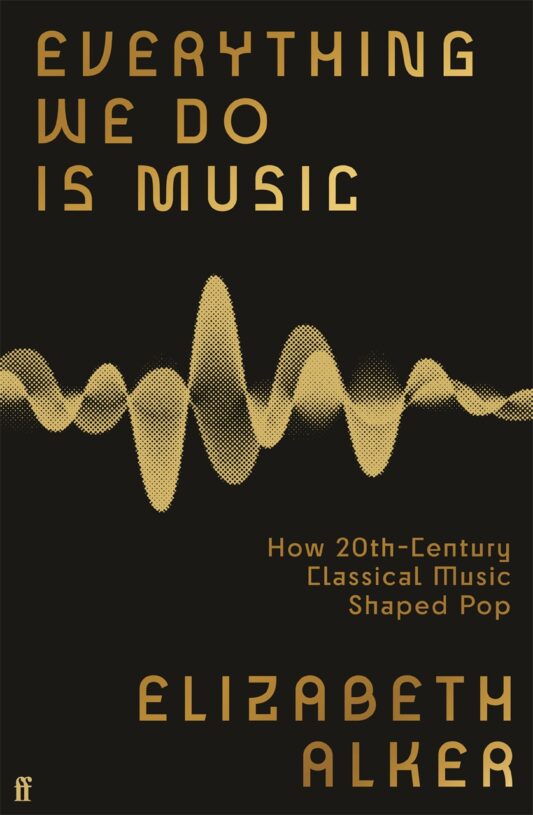Elizabeth Alker: Everything We Do is Music review - Prokofiev goes pop | reviews, news & interviews
Elizabeth Alker: Everything We Do is Music review - Prokofiev goes pop
Elizabeth Alker: Everything We Do is Music review - Prokofiev goes pop
A compelling journey into a surprising musical kinship

Composers and musicians explore acoustic space. Generally, they have got by with combinations of readily accessible sounds, with occasional novelties as instruments improved, bit by bit.
In the 20th century that changed radically. New technologies offered almost unlimited increase in the sounds that could be conjured up on stage or in the studio. And conceptually, the range of sounds some considered musical expanded just as much, abolishing the boundary between music and noise, and even – thanks to John Cage – permitting the composer to propose no sounds at all.
Elizabeth Alker dives into this history with great verve. Her chapters generally pair a well-known track from a pop hit-maker with one or more pioneers of composition or technology, often linking to a scene or scenes where new sounds were mixed, and remixed, by experimentally-minded artists.
In this fashion her book begins in the UK with early experiments in tape manipulation after World War 2, their development by Victoria Derbyshire at the BBC’s Radiophonic Workshop, and the way they fed into The Beatles’ studio productions with George Martin, along with ideas from John Cage and Stockhausen.
 These are the first in an array of music-makers whose work she reports on and puts in context. That reporting includes attending to the music, described well enough to make you want to hear it immediately, interviewing the living artists, or visiting their working milieux and speaking with any surviving collaborators of those no longer around.
These are the first in an array of music-makers whose work she reports on and puts in context. That reporting includes attending to the music, described well enough to make you want to hear it immediately, interviewing the living artists, or visiting their working milieux and speaking with any surviving collaborators of those no longer around.
It’s an impressive effort, with the author equally at ease relating the origins of musique concrète in Paris in the 1950s, recounting the origins of the theremin or the Moog synthesiser, or interviewing superstars such as Paul McCartney or Jean-Michel Jarre.
The way some of the connections play out is exemplified in conversations with DJ Alex Paterson, and producer Martin Glover, AKA Youth, both once part of the late 1980s “chill-out ambient house group” the Orb. As a DJ, Paterson worked in the London club Heaven fashioning soundtracks that “completely altered the tempo and texture of British club music”, Alker suggests. She relates how he came across a recording of minimalist composer Steve Reich’s 1987 piece for electric guitar and tape Electric Counterpoint by the jazz guitar star Pat Metheny.
A sample of Metheny’s guitar riff soon underlay Orb’s most heard recording. Later, Paterson developed the use of sampled sounds and loops further, and made more music that interviewer and subject both aver was classically inspired. Alker reports them discussing “the way that loops – sampled extracts of existing records – are, really, just like a leitmotif in a symphony, or a canon… Or a ground bass in a Baroque chaconne or passacaglia”. It may not be the first comparison that comes to mind for pieces that supplemented techno in marathon ecstasy-fuelled club sessions, but it brings the music into the book’s narrative neatly.
All this is fascinating, and generally convincing, as she moves through a list of artists as varied as Edgar Varese, Terry Riley, LaMonte Young, Brian Eno, Can, Kraftwerk, Bootsy Collins and the Velvet Underground. However, as the chapters unfold, it becomes apparent that the framing narrative is a little too simple. The interactions between musicians, technologists, and other artists, are multifarious and wonderfully complex. Alker’s reporting, in fact, is good enough to belie her subtitle. It’s not that helpful to have to use the awkward term ‘classical’, where lack of a good alternative has led to a fairly nonsensical extension of the original meaning to denote any music that is formally composed, respected in concert halls, and perhaps, nowadays, academe. More importantly, the implied one-way traffic – classical “shaping” pop – doesn’t really fit. What Alker depicts is a wide range of creative artists, trying to respond to the triumphs and tragedies of the last century, and grabbing anything they can lay hands on to help them express their feelings. It's probably true, though, that the simpler framing may encourage fans of Donna Summer or Radiohead to read about Stockhausen, Penderecki, or Cage.
It also, I suppose, helps create order in what could be a difficult history to navigate. Alker’s openness to new sounds and the range of her enthusiasms is admirable, if slightly dazzling. Each chapter deals with a different acoustic world, and, like all good music books, her writing invites pausing to listen to new things, or revisit old ones with a different appreciation. It’s a book to keep on the shelf to cue new exploration when the stuff you have been listening to feels a little too predictable.
The description fits another excellent recent title from the same publisher, one that prompts a final acknowledgment for one of the conditions of this book’s excellence. Alker’s day job is as a presenter for BBC Radio 3, after stints with Radio 6 Music. It’s hard to imagine anywhere better for an ace communicator who is at home with a vast range of contemporary composition as well as the full gamut of pop genres to develop their work. Her book comes just a few years after fellow Radio 3 person Kate Molleson’s Sound Within Sound, which concerns 20th-century composers who deserve a wider hearing. The books go together very well, and it seems fair to take both as added benefits of the licence fee. Lisa Nandy, please note.
- Everything We Do is Music: How 20th-Century Classical Music Shaped Pop by Elizabeth Alker (Faber & Faber, £20)
- More book reviews on theartsdesk
rating
Share this article
The future of Arts Journalism
You can stop theartsdesk.com closing!
We urgently need financing to survive. Our fundraising drive has thus far raised £49,000 but we need to reach £100,000 or we will be forced to close. Please contribute here: https://gofund.me/c3f6033d
And if you can forward this information to anyone who might assist, we’d be grateful.

Subscribe to theartsdesk.com
Thank you for continuing to read our work on theartsdesk.com. For unlimited access to every article in its entirety, including our archive of more than 15,000 pieces, we're asking for £5 per month or £40 per year. We feel it's a very good deal, and hope you do too.
To take a subscription now simply click here.
And if you're looking for that extra gift for a friend or family member, why not treat them to a theartsdesk.com gift subscription?
more Books
 'We are bowled over!' Thank you for your messages of love and support
Much-appreciated words of commendation from readers and the cultural community
'We are bowled over!' Thank you for your messages of love and support
Much-appreciated words of commendation from readers and the cultural community
 Elizabeth Alker: Everything We Do is Music review - Prokofiev goes pop
A compelling journey into a surprising musical kinship
Elizabeth Alker: Everything We Do is Music review - Prokofiev goes pop
A compelling journey into a surprising musical kinship
 Natalia Ginzburg: The City and the House review - a dying art
Dick Davis renders this analogue love-letter in polyphonic English
Natalia Ginzburg: The City and the House review - a dying art
Dick Davis renders this analogue love-letter in polyphonic English
 Tom Raworth: Cancer review - truthfulness
A 'lost' book reconfirms Raworth’s legacy as one of the great lyric poets
Tom Raworth: Cancer review - truthfulness
A 'lost' book reconfirms Raworth’s legacy as one of the great lyric poets
 Ian Leslie: John and Paul - A Love Story in Songs review - help!
Ian Leslie loses himself in amateur psychology, and fatally misreads The Beatles
Ian Leslie: John and Paul - A Love Story in Songs review - help!
Ian Leslie loses himself in amateur psychology, and fatally misreads The Beatles
 Samuel Arbesman: The Magic of Code review - the spark ages
A wide-eyed take on our digital world can’t quite dispel the dangers
Samuel Arbesman: The Magic of Code review - the spark ages
A wide-eyed take on our digital world can’t quite dispel the dangers
 Zsuzsanna Gahse: Mountainish review - seeking refuge
Notes on danger and dialogue in the shadow of the Swiss Alps
Zsuzsanna Gahse: Mountainish review - seeking refuge
Notes on danger and dialogue in the shadow of the Swiss Alps
 Patrick McGilligan: Woody Allen - A Travesty of a Mockery of a Sham review - New York stories
Fair-minded Woody Allen biography covers all bases
Patrick McGilligan: Woody Allen - A Travesty of a Mockery of a Sham review - New York stories
Fair-minded Woody Allen biography covers all bases
 Howard Amos: Russia Starts Here review - East meets West, via the Pskov region
A journalist looks beyond borders in this searching account of the Russian mind
Howard Amos: Russia Starts Here review - East meets West, via the Pskov region
A journalist looks beyond borders in this searching account of the Russian mind
 Henry Gee: The Decline and Fall of the Human Empire - Why Our Species is on the Edge of Extinction review - survival instincts
A science writer looks to the stars for a way to dodge our impending doom
Henry Gee: The Decline and Fall of the Human Empire - Why Our Species is on the Edge of Extinction review - survival instincts
A science writer looks to the stars for a way to dodge our impending doom
 Jonathan Buckley: One Boat review - a shore thing
Buckley’s 13th novel is a powerful reflection on intimacy and grief
Jonathan Buckley: One Boat review - a shore thing
Buckley’s 13th novel is a powerful reflection on intimacy and grief
 Help to give theartsdesk a future!
Support our GoFundMe appeal
Help to give theartsdesk a future!
Support our GoFundMe appeal

Add comment